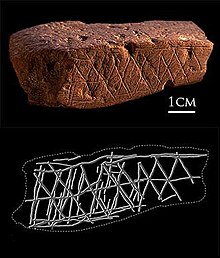Paleolithic religion
One theory links the germination of behavioral innovations to a cultural revolution among early modern humans, which coincided with their arrival to Europe 40,000 years ago.
According to a third theory, characteristics that define behavioral modernity are not unique to the Homo sapiens, but arose over a long period of time, among different human types, including Neanderthals.
[5] Not even the loosest evidence for ritual exists prior to 500,000 years before the present, though archaeologist Gregory J. Wightman notes the limits of the archaeological record means their practice cannot be thoroughly ruled out.
[6] The early hominins of the Lower Paleolithic—an era well before the emergence of H. s. sapiens—slowly gained, as they began to collaborate and work in groups, the ability to control and mediate their emotional responses.
Durham University professor of archaeology Paul Pettitt reads the AL 333 fossils, a group of Australopithecus afarensis found together near Hadar, Ethiopia, as perhaps deliberately moved to the area as a mortuary practice.
Though archaeologist Kit W. Wesler states "there is no evidence in the Lower Paleolithic of the kind of cultural elaboration that would imply a rich imagination or the level of intelligence of modern humans", he discusses the findings of Homo heidelbergensis bones at Sima de los Huesos and the evidence stretching from Germany to China for cannibal practices amongst Lower Paleolithic humans.
[12] A number of skulls found in archaeological excavations of Lower Paleolithic sites across diverse regions have had significant proportions of the brain cases broken away.
[13] For the opposite position, Wunn finds the cannibalism hypothesis bereft of factual backing; she interprets the patterns of skull damage as a matter of what skeletal parts are more or less preserved over the course of thousands or millions of years.
One Upper Paleolithic remnant that draws cultural attention are the Venus figurines, carved statues of nude women speculated to represent deities, fertility symbols, or ritual fetish objects.
The Venus of Berekhat Ram is one such highly speculative figure, a scoria dated 300–350 kya[note 2] with several grooves interpreted as resembling a woman's torso and head.
Scanning electron microscopy found the Venus of Berekhat Ram's grooves consistent with those that would be produced by contemporary flint tools.
[18] These figurines were possibly produced by H. heidelbergensis, whose brain sizes were not far behind those of Neanderthals and H. s. sapiens, and have been analyzed for their implications for the artistic understanding of such early hominins.
The emergence of revolutionary technologies such as fire, coupled with the course of human evolution extending development to include a true childhood and improved bonding between mother and infant, perhaps broke new ground in cultural terms.
Later Lower Paleolithic hominins built wind shelters to protect themselves from the elements; they collected unusual natural objects; they began the use of pigments such as red ochre.
While the full significance of these changes is difficult to discern, they clearly map to an advance in cognitive capacity in the directions that would eventually lead to religion.
Eating the flesh of deceased in order to inherit their qualities or honor them is a practice that has been noted in numerous modern societies, such as the Wariʼ people,[29] and evidence of it may be found in middle Paleolithic as well.
Ritual cannibalism has been suggested for the Krapina Neanderthals, based on three factors: mixing of animals and human skeletal remains, breaking of long bones (in order to access the marrow), and the fact that not a single skull was found in a non-broken state.
Although controversial, the idea of possible cannibalism was supported by a number of subsequent scientists, such as Mirko Malez, H. Ulrich and K. Tomić Karlović.
[43] The oldest cave art so far discovered, is from the island of Sulawesi in Indonesia, dated to 45 500 BP, depicting a warty pig and hand traces.





